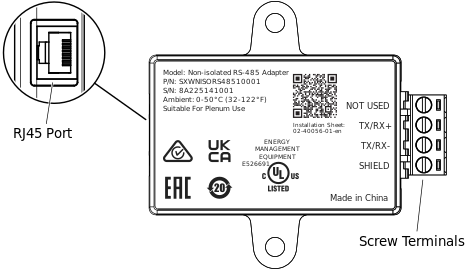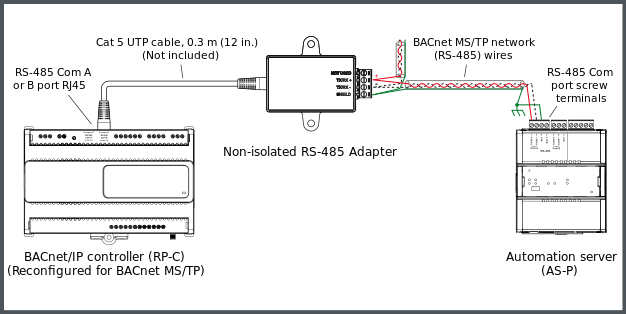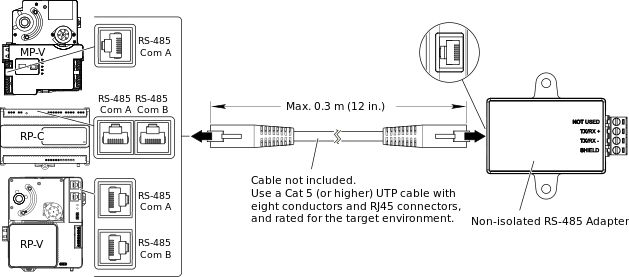The Non-isolated RS-485 Adapter is equipped with an RJ45 port for connection to a BACnet/IP controller RS-485 Com port and a 4-position removable screw terminal block for connection to a BACnet MS/TP (RS-485) network.
action_zoom_plus_stroke

RJ45 port and screw terminals, Non-isolated RS-485 Adapter
The following figure shows an example of how a Non-isolated RS-485 Adapter is connected to one of the RS-485 Com ports (RJ45) of an RP-C controller via a Cat 5 (or higher) UTP cable of maximum length 0.3 m (12 in.) and how the BACnet MS/TP network (RS-485) wires from the adapter are connected to the RS-485 Com port screw terminals of an AS-P server.
action_zoom_plus_stroke

Example with a Non-isolated RS-485 Adapter used for connection of an RP-C controller to a BACnet MS/TP network and an AS-P server
Connection of RJ45 port to BACnet/IP controller RS-485 Com port
A separate connection cable is required to connect the RJ45 port on the RS-485 adapter to the RS-485 Com port (RJ45) on the BACnet/IP controller. The cable is not included and needs to be purchased separately.
Use a Cat 5 (or higher) unshielded, straight-through wired cable with eight conductors (four twisted pairs) and RJ45 connectors. Use a cable with the wire size (cross-sectional area) 22 to 26 AWG (0.34 to 0.14 mm²), a maximum length of 0.3 m (12 inches), and a rating that meets the requirements of the target environment. For example, when devices are installed in a space that handles conditioned air or return air, the cables typically need to be plenum-rated.
|
Notice
|
|
LOSS OF COMMUNICATION
Ensure that the length of the cable for connection of the RS-485 adapter to the controller does not exceed 0.3 m (12 inches).
Use a Cat 5 or higher unshielded twisted pair cable with eight conductors (four twisted pairs), a cross-sectional area of 22 to 26 AWG (0.34 to 0.14 mm
2
), and a rating that meets the requirements of the target environment.
Failure to follow these instructions can result in loss of communication.
|
For more information, see Connecting a Non-isolated RS-485 Adapter
.
For more information, see RJ45 Pinout for the RS-485 Ports of the RP-C Controller
.
Wiring of screw terminals for connection to BACnet MS/TP network
The four screw terminals are wired and connected to a BACnet MS/TP (RS-485) network as described in the following table.
Recommended screw tightening torque: 0.5 Nm (4.5 lbf.in)
Table: Screw Terminals, Non-isolated RS-485 Adapter
|
Terminal
|
Usage
|
|
NOT USED
|
Not connected.
|
|
TX/RX+
|
Data line (+) for connection to the TX/RX+ signal in the BACnet MS/TP twisted pair connecting all devices on the bus.
|
|
TX/RX–
|
Data line (–) for connection to the TX/RX– signal in the BACnet MS/TP twisted pair connecting all devices on the bus.
|
|
SHIELD
|
Convenience terminal to interconnect two shield drain wires (incoming and outgoing). There is no electrical connection in the adapter. The shield should be connected to ground at only one location and that is recommended to be at the automation server. The shield should not be connected directly to the RET terminal on the automation server. The transient energy on the drain wire should be conducted to ground and not through the automation server.
|
For more information, see Wiring the Screw Terminals on a Non-isolated RS-485 Adapter
.
For more information, see RS-485 Communications
.


 Non-isolated RS-485 Adapter Connection and Wiring
Non-isolated RS-485 Adapter Connection and Wiring
 RP-C BACnet MS/TP Support
RP-C BACnet MS/TP Support
 Allocating Flexible Ports
Allocating Flexible Ports
 Installing an RS-485 Adapter
Installing an RS-485 Adapter
 Wiring the Screw Terminals on a Non-isolated RS-485 Adapter
Wiring the Screw Terminals on a Non-isolated RS-485 Adapter

